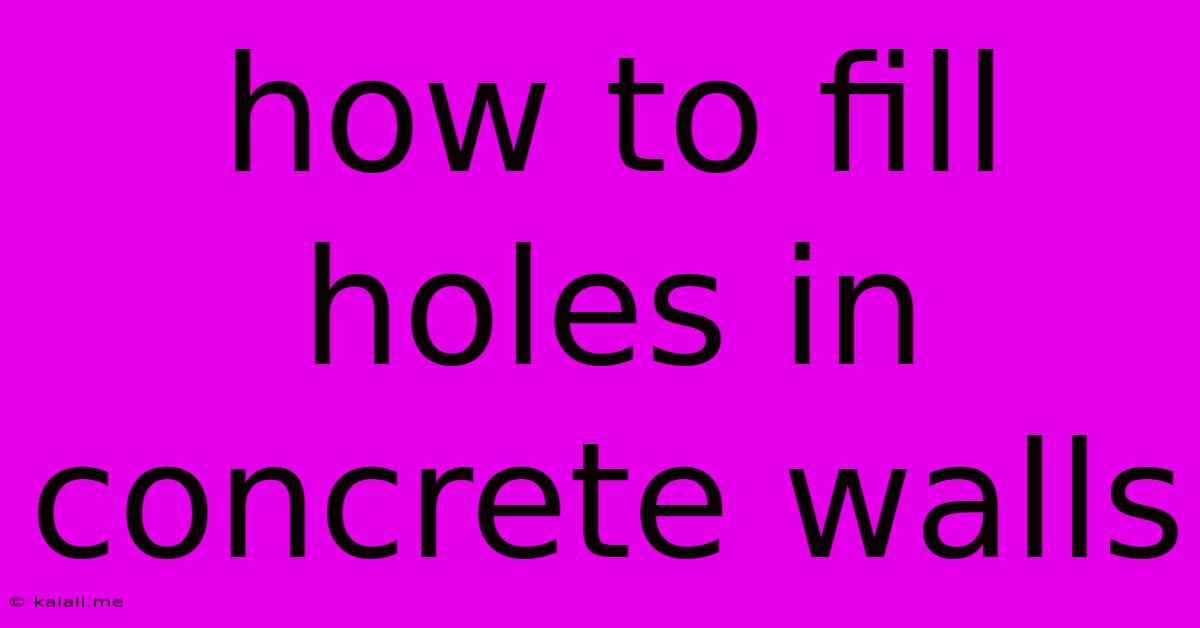How To Fill Holes In Concrete Walls
Kalali
May 25, 2025 · 4 min read

Table of Contents
How to Fill Holes in Concrete Walls: A Comprehensive Guide
Repairing holes in concrete walls is a common DIY task, but doing it right requires the right approach and materials. This comprehensive guide will walk you through the process, from assessing the damage to achieving a seamless finish. This article covers everything from small cracks to larger holes, ensuring your concrete wall repairs are both effective and aesthetically pleasing. Whether you're a seasoned DIYer or a complete novice, you'll find valuable information here to help you tackle this home improvement project.
Assessing the Damage: The First Step to Success
Before you even think about grabbing your tools, take a moment to thoroughly assess the hole in your concrete wall. This initial inspection will determine the best repair method and the materials you'll need. Consider these factors:
- Size and Depth: Small cracks and minor chips require a different approach than larger, deeper holes.
- Cause of the Damage: Understanding the cause (impact, weathering, etc.) can help prevent future damage.
- Location: The location of the hole (interior vs. exterior, above ground level, etc.) will influence your choice of repair materials.
- Presence of Rebar: Check if any reinforcing steel (rebar) is exposed. This will affect your repair strategy.
Gathering Your Tools and Materials: Preparing for the Repair
Having the right tools and materials on hand will make the repair process much smoother and more efficient. For most repairs, you'll need:
- Safety Gear: Safety glasses, gloves, and a dust mask are essential to protect yourself from dust and debris.
- Chisel and Hammer: To remove any loose or crumbling concrete around the hole.
- Wire Brush: To clean the hole and remove any loose particles.
- Vacuum: To remove dust and debris from the area.
- Concrete Repair Mortar or Epoxy: Choose a product appropriate for the size and location of the hole. Epoxy is ideal for smaller holes and cracks, while mortar is better for larger repairs. Consider using a patching compound specifically designed for concrete repairs.
- Mixing Bucket and Trowel: For mixing the repair material.
- Putty Knife or Caulk Gun (depending on the product): For applying the repair material.
- Level: To ensure a smooth, even surface.
- Sandpaper: To smooth the repaired area once it has dried.
- Primer and Paint (if necessary): To match the surrounding wall.
Repairing the Hole: A Step-by-Step Guide
Once you've assessed the damage and gathered your materials, you can begin the repair process:
- Clean the Area: Remove any loose concrete, debris, and dust from the hole using a chisel, hammer, and wire brush. Thoroughly clean the area with a vacuum.
- Prepare the Repair Material: Follow the manufacturer's instructions for mixing the concrete repair mortar or epoxy. Ensure the mixture is consistent and free of lumps.
- Apply the Repair Material: Carefully fill the hole with the repair material, using a putty knife or caulk gun to create a smooth, even surface. Slightly overfill the hole.
- Level the Surface: Use a trowel or putty knife to level the repaired area. A level will help ensure a smooth, even finish.
- Allow to Dry: Allow the repair material to dry completely according to the manufacturer's instructions. This may take several hours or even overnight, depending on the product and the weather conditions.
- Sand and Finish: Once the repair material is dry, sand the area smooth with sandpaper. Prime and paint the repaired area to match the surrounding wall, if necessary.
Choosing the Right Repair Material: Mortar vs. Epoxy
The choice between concrete repair mortar and epoxy depends on the size and type of damage:
- Epoxy: Ideal for small cracks and holes, providing a strong, durable bond. It cures quickly and shrinks minimally.
- Mortar: Best suited for larger holes and significant damage. It offers good strength and is relatively inexpensive.
Preventing Future Damage: Proactive Measures
Addressing the underlying cause of the hole is crucial to prevent future damage. This might involve:
- Addressing Water Damage: Repairing leaks and ensuring proper drainage to prevent water from seeping into the concrete.
- Protecting Against Impacts: Installing protective coverings or barriers to minimize the risk of impact damage.
By following these steps and choosing the appropriate materials, you can effectively repair holes in your concrete walls and maintain the structural integrity and aesthetic appeal of your home. Remember, safety is paramount, so always wear appropriate safety gear. With a little patience and the right techniques, you can achieve professional-looking results.
Latest Posts
Latest Posts
-
Why Does My Car Ac Smell
May 25, 2025
-
How To Say And In German
May 25, 2025
-
Prime Rib Vs Standing Rib Roast
May 25, 2025
-
Skyrim What Counts As A Skill Enchantment
May 25, 2025
-
Is It Open Sesame Or Open Says Me
May 25, 2025
Related Post
Thank you for visiting our website which covers about How To Fill Holes In Concrete Walls . We hope the information provided has been useful to you. Feel free to contact us if you have any questions or need further assistance. See you next time and don't miss to bookmark.